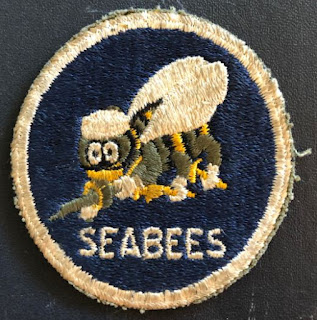For today’s post, I share four pieces of Navy memorabilia that belonged to my father-in-law, Earl Murphy. Earl served in the U.S. Navy from February 1946 to December 1948.
 |
Earl Lloyd Murphy |
The first item is a book, The Bluejackets’ Manual, 12th edition, published by the United States Naval Institute (Annapolis, Maryland) in 1944. According to Wikipedia, the book is “… the basic handbook for United States Navy personnel. First issued in 1902 to teach recruits about naval procedures and life and offer a reference for active sailors, it has become the “bible” for Navy personnel, providing information about a wide range of Navy topics. The current version, issued in 2017, is the 25th Edition and is given to all enlistees.”
My husband Charlie received The Bluejackets’ Manual, and the other three items, after the death of his father in 2015. This soft cover book has seen better days—the cover is separating from the spine, pages are yellowing, and the edges of the cover and pages are fraying. Much of this probably stems from the hours my husband and his brother Pat spent thumbing through the pages as boys. They both told me they were fascinated by the book, especially Pat. They were interested in everything in it. The book hadn’t seen the light of day since coming into our home in 2015 until a month ago when Charlie came across it while cleaning his office. He mentioned it to Pat, who of course, wanted to see it again. Pat’s eyes lit up when Charlie handed the book to him. As Pat thumbed through the pages once again, he recalled doing the same thing years ago, as mentioned above, for hours at a time. He remembered looking at the signal flags—the colors and what they meant, positions of a rifleman, how to site a gun to hit a bullseye, and tons of ship classifications. He vaguely remembers pictures of trees, how to avoid the moonlight and sunlight shadows so the enemy didn’t see you. It all amazed him. As a young boy, Pat said they played cowboys and Indians and cops and robbers. Pat remembers that at the height of the Vietnam war, they played Army a lot, using lifelike looking guns—guns that wouldn’t fly in today’s world because they looked so real. But he said at the time, the whole neighborhood knew what they were doing. They were playing and having fun. I asked Pat if he remembers using any of the tactics he learned from the book and he said “probably” with a laugh. Charlie remembered the insignias, different types of ships, how to shoot and tie knots, the proper way to salute, and survival techniques such as what you could and couldn’t eat. Charlie said they probably read the book more than their dad did when he was in the Navy. The book brought fond memories to both of them.
The second item is Earl’s vintage Seabees patch (ca. 1946). The patch is in pretty good shape. It doesn’t appear to have been sewn onto a uniform at any point in time. The Naval History and Heritage Command website describes Seabees history during World War II (or rather “Between the Second World War and the Korean War”) as “Following the victories in Europe and Asia, the U.S. Armed Forces rapidly demobilized. The Seabees were part of this demobilization, and by June 1946 their number had fallen from a peak strength of more than 250,000 men to approximately 20,000. In the continental United States, the web of training bases and depots dissolved, and all Seabee activity was concentrated at the Naval Construction Battalion Center, Port Hueneme, California. …” We can place Earl at Port Hueneme in August 1946 when I learned he was involved in Atomic bomb test number 6, something my husband wasn’t aware of.
The third item is Earl’s vintage U.S. Navy ring. The sterling silver ring is very worn, although Charlie doesn’t remember his dad ever wearing it. It has an anchor with the letters USN on the front and an eagle on both sides. The anchor is worn so much it almost looks like a skull.
The fourth item is an anchor lapel pin. The pin is gold plated, and although a bit tarnished, is in good condition. It could use a good cleaning. We don’t know if this was part of Earl’s uniform or if it was just something he randomly purchased at some point. Earl was one of four Murphy sons in his family and he was the only one to serve in the Navy so at least we know it belonged to him.
In the following link, you can read about Earl’s war medals. These, and the four items above, are all treasured family heirlooms.
References
- Seabee History: Between the Second World War and the Korean War, Seabee History – 1946–1960, Naval History and Heritage Command; https://www.history.navy.mil/research/library/online-reading-room/title-list-alphabetically/s/seabee-history0/1946-1960.html.
- The Bluejacket’ Manual, https://en.wikipedia.org/wiki/The_Bluejacket's_Manual.





No comments:
Post a Comment